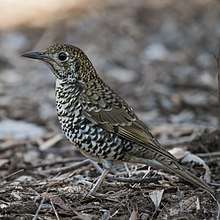Bassian thrush
| Bassian thrush | |
|---|---|
 | |
| Bassian thrush at Australian National Botanic Gardens, Canberra, Australia | |
| Scientific classification | |
| Kingdom: | Animalia |
| Phylum: | Chordata |
| Class: | Aves |
| Order: | Passeriformes |
| Family: | Turdidae |
| Genus: | Zoothera |
| Species: | Z. lunulata |
| Binomial name | |
| Zoothera lunulata (Latham, 1801) | |
| Subspecies | |
| |
The Bassian thrush (Zoothera lunulata), also known as the olive-tailed thrush, is a medium-sized mostly insectivorous thrush found predominantly in southeastern Australia and Tasmania. The thrushes range from 27 to 29 cm (10.5 to 11.5 in) in length and average 100 g (3.5 oz).[2]
It is estimated that the rangewide population is large, though no official count has ever been established.[3]
The Bassian thrush lives in shrubland, forests, and rainforests.[4] It is non-migratory. Though affected by human destruction of its natural habitats, its range is so large that the impact is negligible.[3]
The thrush ranges in color from brown to an olive color, with a white ring around its eyes and black bars on its back, rear, and head. Its underbody is paler, with dark scalloping, and its wings have a dark bar running the length of the underside.[2]
Gallery
 Bassian thrush at Australian National Botanic Gardens, Canberra
Bassian thrush at Australian National Botanic Gardens, Canberra Bassian thrush at Southwest National Park, Tasmania
Bassian thrush at Southwest National Park, Tasmania Bassian thrush at Bruny island, Tasmania
Bassian thrush at Bruny island, Tasmania
References
- ↑ BirdLife International (2012). "Zoothera lunulata". IUCN Red List of Threatened Species. Version 2013.2. International Union for Conservation of Nature. Retrieved 26 November 2013.
- 1 2 "Birds in Backyards: Bassian Thrush". Birdlife Australia. Retrieved 25 July 2014.
- 1 2 "Species factsheet: Bassian Thrush Zoothera lunulata". BirdLife International. Retrieved 25 July 2014.
- ↑ "Species Zoothera lunulata (Latham 1801): Bassian Thrush". Australian Government: Department of the Environment. Retrieved 25 July 2014.
